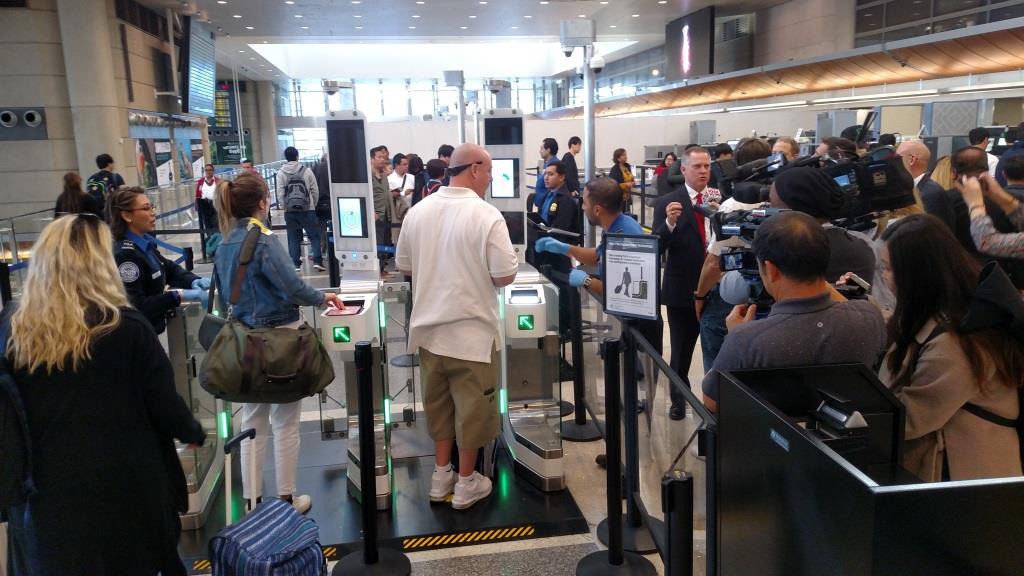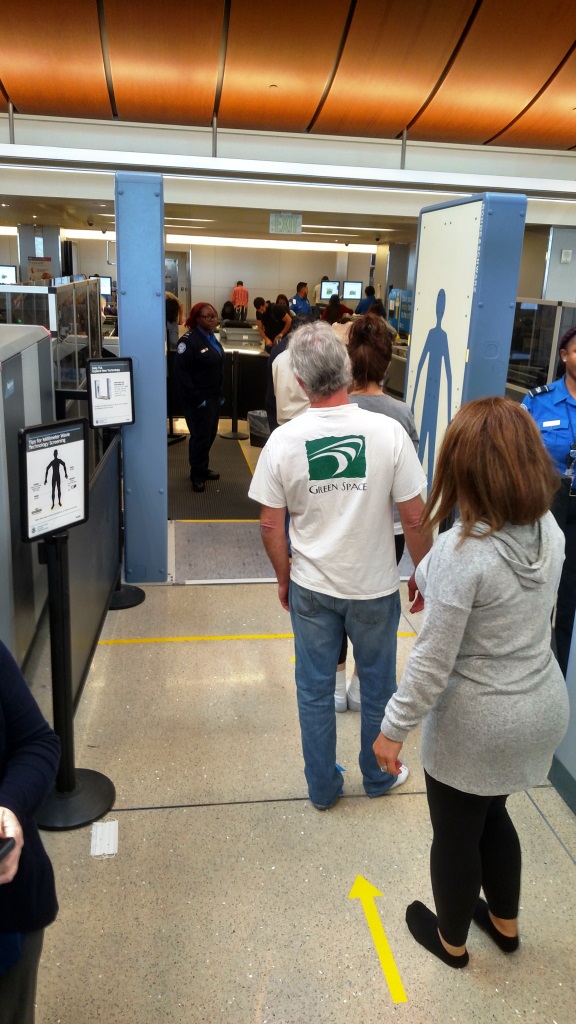
For Immediate Release
February 16, 2018
Contact:
Charles Pannunzio, LAX Public Relations
(424) 646-5260 cpannunzio@lawa.org
Lorie Dankers, TSA Public Affairs
(206) 743-1497 lorie.dankers@tsa.dhs.gov
Passengers in the Tom Bradley International Terminal try out the facial recognition E-gates that are being tested in the Security Screening Check Point on Friday.
(Los Angeles, CA) The Transportation Security Administration (TSA) and Los Angeles World Airports (LAWA) today highlighted two security checkpoint technologies that are currently being piloted at Los Angeles International Airport’s (LAX) Tom Bradley International Terminal (TBIT). These systems are designed to enhance security while easing the screening process for travelers.
One of the pilot projects being demonstrated uses facial recognition technology to automate the identification and boarding pass verification process. Travelers who are ticketed on an international flight can opt to use the biometric recognition system to verify their identity.
After a traveler scans their boarding pass and passport, a camera activates and takes a photo of the passenger. The system verifies that the name on the boarding pass and passport match. It also confirms that the passport photo and the photo taken by the camera match. If any of these items do not match, the passenger is not granted access to the security checkpoint. During the pilot program, all travelers will still have their boarding and identity documents manually verified by a TSA officer.
Passengers line up to use the enhanced Advanced Imaging Technology (AIT) unit that is being tested in the Tom Bradley International Terminal's Security Screening Check Point.
The second pilot project features an enhanced Advanced Imaging Technology (AIT) unit with increased detection capabilities. The enhanced AIT, commonly referred to as a body scanner, does not require travelers to raise their hands over their head during the scan. In addition, it also provides corrective feedback to the TSA officer, alerting the officer if a passenger is improperly positioned in the unit. This capability may allow passengers to adjust their stance and be rescanned, which could reduce the need for a pat down.
“Our selection as a TSA Innovation Task Force site gives LAWA the opportunity to see how these new products could help improve the guest experience at LAX,” said LAWA Chief Innovation and Commercial Strategy Officer Justin Erbacci. “We are excited about the way these technologies can help smooth the journey for passengers using LAX while enhancing security at the same time.”
“TSA’s strong partnership with LAWA has allowed the agency to pilot emerging technologies and evaluate their performance real-time in a busy security checkpoint environment,” said Steve Karoly, TSA’s Acting Assistant Administrator for Requirements and Capabilities and Analysis. “We look forward to continuing this relationship to identify ways to increase the security effectiveness and efficiency of the passenger experience.”
Another technology that was tested and later installed at LAX is automated screening lanes (ASLs).ASLs have several features designed to improve the screening of travelers’ carry-on baggage by automating many of the functions previously conducted manually.
Travelers are able to move more swiftly through the checkpoint thanks to side-by-side divesting areas where several passengers can place their items in bins simultaneously. Automated conveyor belts move bins into the X-ray machine tunnel and return the bins to the front of the security checkpoint. The system features automatic diversion of any carry-on bag that may contain a prohibited item.
ASLs also feature bins that are 25 percent larger than a typical bin and are able to hold a roll-aboard bag. Unique Radio Frequency Identification (RFID) tags are attached to each bin, allowing for additional accountability of a traveler’s carry-on property as they move throughout the security screening process. The airport recently completed installation of four additional ASLs at TBIT, bringing the total number to 10 in the terminal’s security checkpoint.
TSA continues to collaborate with vendors, airlines, airports, and across the counterterrorism community to roll out additional technologies. TSA’s long-term goal is to incorporate enhanced capabilities at checkpoint lanes throughout the country.
LAWA Chief Innovation and Commercial Strategies Officer Justin Erbacci speaks with the media during Friday morning's technology demonstration at the Tom Bradley International Terminal.
About the Transportation Safety Administration (TSA)
The Transportation Security Administration was created to strengthen the security of the nation’s transportation systems and ensure the freedom of movement for people and commerce. TSA uses a risk-based strategy and works closely with the transportation, law enforcement and intelligence community to set the standard for excellence in transportation security. For more information about TSA, please visit our website at tsa.gov.
About Los Angeles International Airport (LAX)
LAX is the fourth busiest airport in the world, second in the United States, and was named Skytrax’ 2017 Top 10 Most Improved Airports. LAX served more than 80.9 million passengers in 2016. LAX offers 737 daily nonstop flights to 100 cities in the U.S. and 1,386 weekly nonstop flights to 88 cities in 44 countries on 73 commercial air carriers. LAX ranks 14th in the world and fifth in the U.S. in air cargo tonnage processed, with more than 2.2 million tons of air cargo valued at over $101.4 billion. LAX handled 697,138 operations (landings and takeoffs) in 2016.
An economic study based on 2014 operations reported LAX generated 620,600 jobs in Southern California with labor income of $37.3 billion and economic output (business revenues) of more than $126.6 billion. This activity added $6.2 billion to local and state revenues and $8.7 billion in federal tax revenues. The study also reported that LAX’s ongoing capital-improvement program creates an additional 121,640 annual jobs with labor income of $7.6 billion and economic output of $20.3 billion, $966 million in state and local taxes, and $1.6 billion in federal tax revenues.
LAX is also the second most popular airport in the world to appear on Instagram according to wego.com. LAX is part of a system of two Southern California airports – along with Van Nuys general aviation – that are owned and operated by Los Angeles World Airports, a proprietary department of the City of Los Angeles that receives no funding from the City’s general fund.
For more information about LAX, please visit www.flyLAX.com or follow on Twitter @flyLAXAirport, rel="noopener noreferrer" on Facebook at www.facebook.com/LAInternationalAirport, rel="noopener noreferrer" and on YouTube at www.YouTube.com/laxairport1.
As a covered entity under Title II of the Americans with Disabilities Act, the City of Los Angeles does not discriminate on the basis of disability and, upon request, will provide reasonable accommodation to ensure equal access to its programs, services, and activities. Alternative formats in large print, braille, audio, and other forms (if possible) will be provided upon request.



